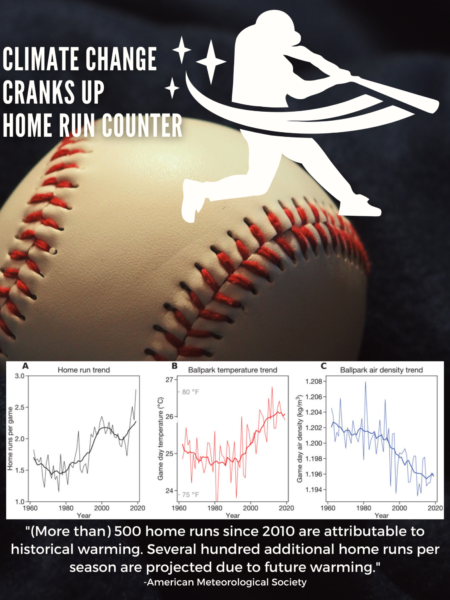Climate change cranks up home run counter
Climate change has increased the number of home runs hit by players–with the SF Giants’ Splash Hit counter at Oracle Park marking 99 splash hits–home runs–into McCovey Cove as of press time. (Photo taken in May 2022 with 93 splash hits.)
May 22, 2023
Climate change affects many aspects on Earth—changes in temperature, rising oceans, and now, baseball.
Studies have shown that climate change may result in higher home run totals in Major League Baseball.
The Bulletin of the American Meteorological Society claims that as many as an extra 500 home runs were hit from 2010-2019 due to climate change, stating that “several hundred additional home runs per season are projected due to future warming.”
The basic premise of this idea is that warmer temperatures lead to less density in the air, allowing for batted balls to carry farther, thus allowing for more home runs.
“It was relatively straightforward. In some ways it was confirming that basic physical understanding that we already had,” Dartmouth student Christopher Callahan told NPR.
Researchers have claimed that by 2050, there will be upwards of an extra 190 home runs hit per year. Climate change, though, is not the biggest factor in terms of home runs. New analytical approaches and swinging for the fences have become key to scoring runs in today’s game of baseball.
Ever since the Moneyball tactic became widespread across the league — taking players in on cheap contracts because their analytics show that they have a very specific skill set — teams and front offices have looked to platooning their players for better matchups.
Platooning is putting a batter in to face an opposite-handed pitcher for a better analytical chance of getting a hit. This creates optimal opportunities for batters to face the type of pitchers they’re good at hitting off of.

According to the American Meteorological Society, climate change has contributed to the increase of home runs of the past few years, and that number will continue to rise as the climate change continues.
Another factor in home runs in the MLB is velocity. Every year it seems pitchers throw harder and harder, with flamethrowers like Camilo Doval, Hunter Greene and Jacob deGrom becoming standard in the MLB.
The increased velocity in pitches allows for more power off the bat and makes the ball go a whole lot farther than it ever has before. Since 2012 the average pitch velocity from MLB starters went up by 2 MPH and has been trending upward ever since.
And one more factor is a little more obvious, hitters are just getting better. With new technologies like WinReality, hitters can see things players have never seen before — virtual pitching. This technology allows them to see their swing path and adjust it to be optimal for them, thus making them better hitters in the process.
Places like Driveline use motion sensors to make a complete 3D render of a batter’s swing so they can see the flaws and what to improve on. This brings baseball to a whole new level of analytics and technology that will be used for years to come.
When asked what the biggest factor in the increase of home runs is, Christian Dubon ‘25 responded by stating, “Probably the players training every day and night, eating good, and just practicing to get better.”













